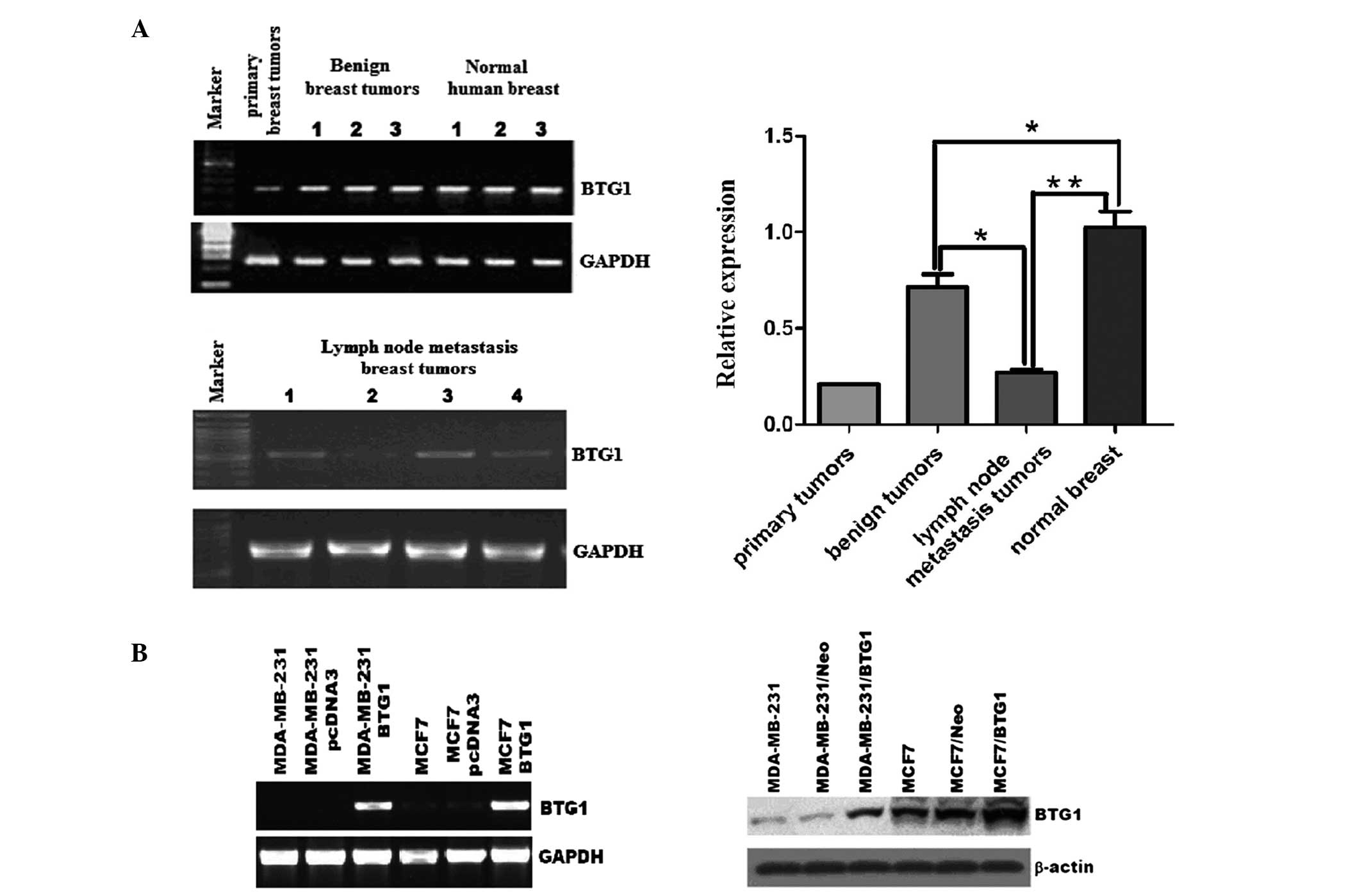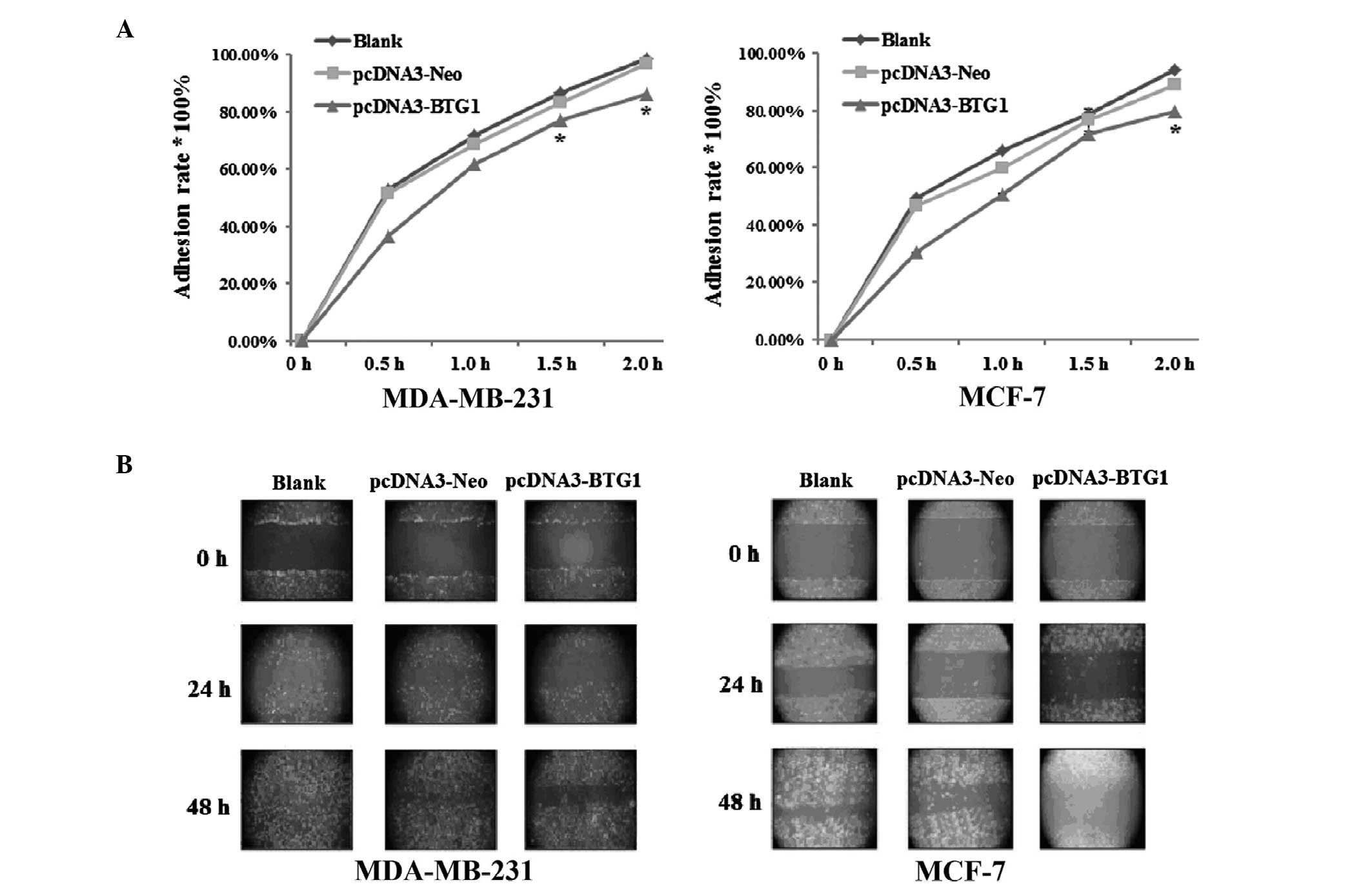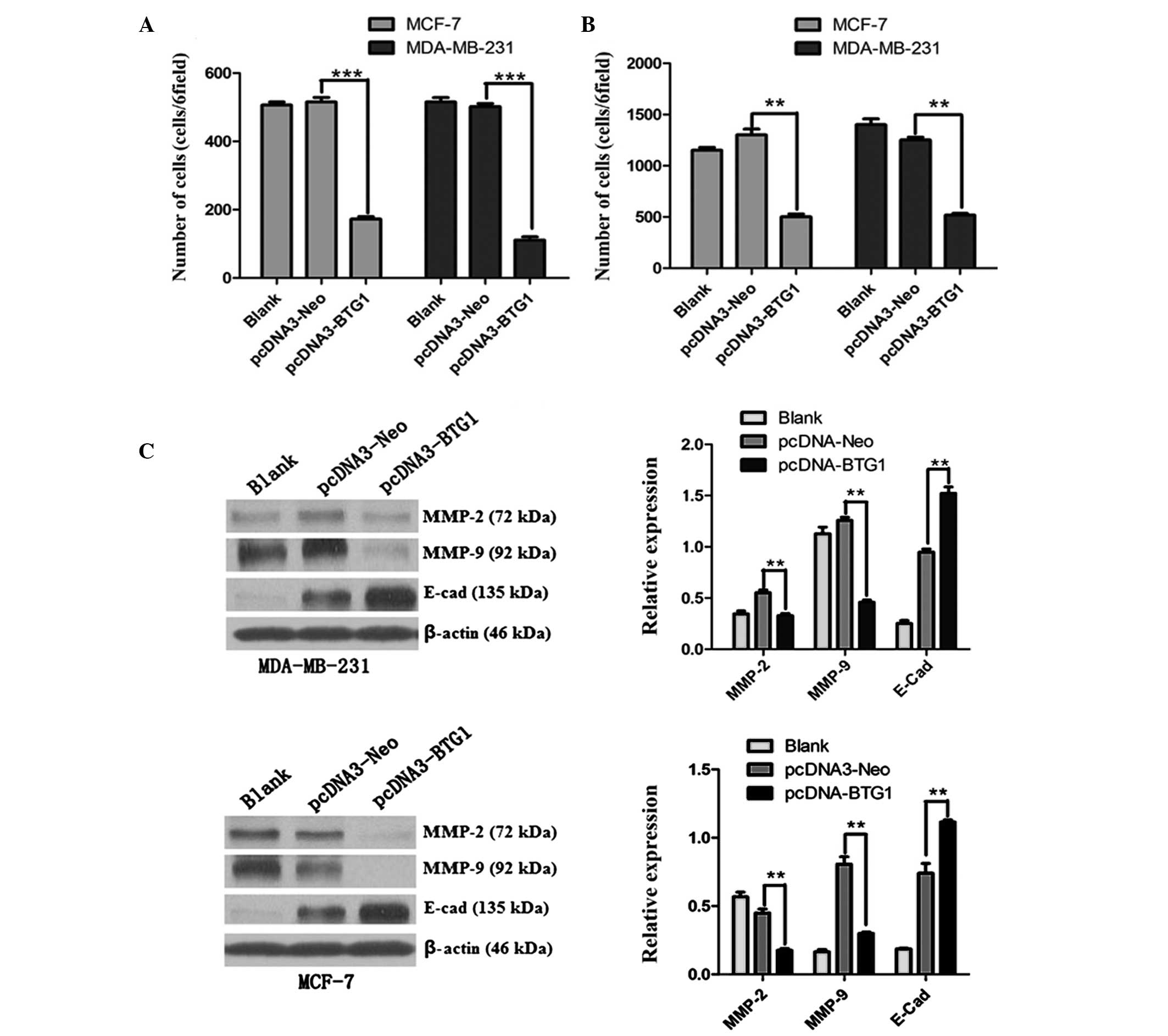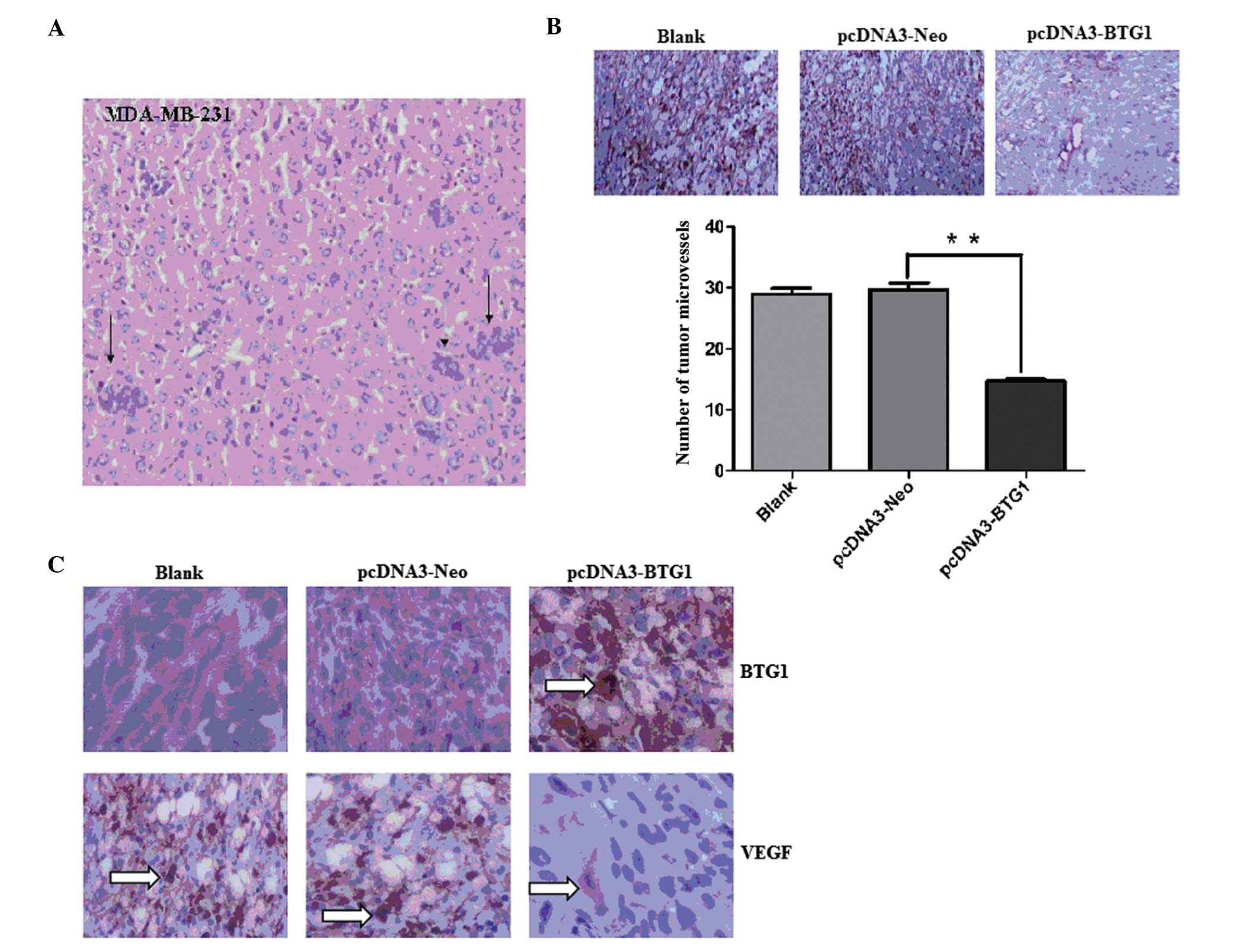Introduction
Tumor metastasis is a significant clinical problem,
which complicates therapeutic cancer treatment and is responsible
for ~90% of all cancer mortalities (1,2). The
clinical efficacy of therapeutic modalities is impaired by the
presence of metastatic tumors. In females, breast cancer accounts
for ~23% of all diagnosed cancer cases, which is the highest among
all types of cancer and accounts for ~7.6 million mortalities
annually worldwide (3). Early
tumor metastasis to different organs is one of the major causes of
low survival rates in patients with breast cancer (2,4,5).
B-cell translocation gene 1 (BTG1) is a member of
the anti-proliferative gene family comprising pheochromacytoma
cell-3, tetradecanoyl phorbol acetate-inducible sequence 21, BTG3,
transducer of ERBB2, 1 (TOB1) and TOB2 (6,7).
BTG1 was originally identified as a sequence associated with a
chromosomal translocation in a lymphoid malignancy (6,8).
Proteins encoded by members of this gene family have been
implicated in the induction of growth arrest or apoptosis in a
variety of cell systems (8).
Overexpression of BTG1 has been found to inhibit proliferation
during normal erythroid differentiation (9) and to induce growth arrest in a B-cell
lymphoma model (10). Furthermore,
exogenous expression of BTG1 has been found to reduce proliferation
and induce G1 arrest and/or apoptosis in several cell
types, including NIH3T3 murine fibroblasts (11), microglia (12) and myoblasts (13). A role for BTG1 in cellular
differentiation has also been proposed based on investigations
showing that BTG1 expression stimulates myoblast differentiation
(13), and that BTG1 is
upregulated in leukemic cells upon treatment with chemicals that
induce differentiation (14).
BTG1 may therefore have a role in inhibiting
proliferation, promoting apoptosis and stimulating cellular
differentiation in multiple cell types. However, the role of BTG1
in cancer metastasis is yet to be elucidated. In the present study,
the effect of BTG1 on breast cancer cell adhesion, migration and
invasion was investigated. In addition, breast cancer distant
metastasis and angiogenesis were also investigated in a nude mouse
tumor model. To the best of our knowledge, this is the first study
to show that overexpression of BTG1 inhibits breast cancer
metastasis.
Materials and methods
Cell culture
Human breast cancer cell lines, MCF-7 and
MDA-MB-231, were obtained from the Shanghai Cell Bank (Shanghai,
China). Cells were cultured in Dulbecco’s Modified Eagle’s medium
(Gibco-BRL, Carlsbad, CA, USA) containing 10% fetal bovine serum in
a humidified atmosphere with 5% CO2 at 37°C. 2. The
present study was approved by the ethics committee of Soochow
University (Suzhou, Jiangsu, China).
Generation of stable cell lines
In order to generate stable cell lines
overexpressing BTG1, cDNAs for full-length human BTG1 were
amplified by the polymerase chain reaction (PCR) with the following
primer sequences: 5′-CACCATGCA TCCCTTCTACACCCGG-3′ (forward) and
5′-TTAACCTGA TACAGTCATCATATTG-3′ (reverse). The full-length cDNA
was then cloned into a XhoI and BamHI linearized
plasmid vector, pcDNA3 (Clontech Laboratories, Mountain View, CA,
USA). The control pcDNA3 vector (pcDNA3-neo) or the human BTG1
expression vector, pcDNA3-BTG1, were transfected into MCF-7 or
MDA-MB-231 cells using Lipofectamine 2000 (Invitrogen Life
Technologies, Carlsbad, CA, USA). Stable clones were selected in
medium containing 500 μg/ml G418 (Sigma-Aldrich, St. Louis, MO,
USA). Individual clones were isolated and expanded for further
characterization. The expression of BTG1 was determined using
reverse transcription (RT)-PCR and western blot analyses.
Cell adhesion assay
A flat-bottomed 96-well plate was coated with 0.2 ml
Matrigel™ (200 μg/ml) overnight at 4°C. Some wells were left
uncoated as negative controls. The plate was washed twice with
phosphate-buffered saline (PBS) and blocked with 1 mg/ml bovine
serum albumin (BSA) for 2 h at 37°C, prior to the addition of 0.5
ml (5×103) cells, which were transfected as described
above. Following incubation at 0.5-, 1-, 1.5- and 2-h intervals at
37°C, unattached cells were removed from the plate by washing with
PBS. MTT (Sigma-Aldrich) was added to each well and the percentage
adhesion was calculated by dividing the absorbance values obtained
from the coated wells by the absorbance values obtained from the
uncoated wells (100%).
Wound-healing assay in vitro
A wound-healing assay was used to detect cell
migration in vitro. Cells were seeded in six-well plates at
a density of 1×106 cells/well and incubated at 37°C for
24 h. When cells were 90% confluent, a thin mark was drawn
vertically with a pipette tip in the six-well plate. Cells were
then washed three times with sterile PBS to remove any unattached
cells. Following incubation for 24 or 48 h at 37°C with 5%
CO2, wound width was assessed using light
microscopy.
Cell invasion and migration assay
Cell invasion was measured using Matrigel-coated
Transwell® inserts (Costar Inc., Cambridge, UK). Cells
were initially cultured in serum-free medium for 12–24 h. A total
of 5×104 (100 μl) cells were then plated in serum-free
medium with BSA on 24-well Transwell inserts coated with 100 ml
Matrigel (250 mg/ml). The underside of the insert was precoated
with 500 μl chemokine-containing cell supernatant. Following
incubation for 48 h at 37°C with 5% CO2, the inserts
were fixed with 3.7% paraformaldehyde/PBS and stained with 2%
crystal violet. The penetration of cells through the membrane was
quantified by counting the number of cells that penetrated the
membrane in 10 microscopic fields/filter (magnification, ×200). The
experiment was repeated three times. Cell migration assays were
performed in a similar manner, but without the Matrigel
coating.
Western blot analysis
Each experimental group of cells was lysed using SDS
sample buffer (80 mM Tris-HCl, 2% SDS, 300 mM NaCl and 1.6 mM
EDTA). Cell extracts were separated using 10% SDS-PAGE, transferred
onto nitrocellulose membranes and blocked with 5% skimmed milk.
Following blocking, membranes were incubated with antibodies
against β-actin, BTG1, matrix metalloproteinase (MMP)-2, MMP-9 and
E-cadherin (E-cad) (Santa Cruz Biotechnology, Inc., Santa Cruz, CA,
USA), and then incubated with horseradish peroxidase
(HRP)-conjugated anti-mouse or -rabbit immunoglobulin G antibodies
(Santa Cruz Biotechnology, Inc.). Protein bands were visualized
using enhanced chemiluminescence solution.
In vivo studies
Four-week old female nude mice (specific
pathogen-free BALB/c) were obtained from the Laboratory Animal
Center of Soochow University (Suzhou, China) and housed at a
constant temperature (23±2°C) and humidity (50–70%) with a 12-h
light/dark cycle. MDA-MB-231 cells were either transfected with
pcDNA3-BTG1 or pcDNA3-neo (negative control), or left untreated
(blank), as described previously. Cells were grown to
subconfluency, trypsinized, harvested, washed twice with PBS and
resuspended in 0.2 ml PBS (5×106 cells/0.2 ml), prior to
subcutaneous injection into the three groups of mice. Each group
contained six nude mice. Five weeks after injection, the presence
of metastases in the lung and liver tissues from each mouse bearing
a tumor mass on the back was evaluated by gross and microscopic
examination. Tissue sections were deparaffinized, rehydrated and
rinsed, prior to hematoxylin and eosin staining and examination for
metastatic nodules and cell pathology.
Immunohistochemistry
Tumor xenografts were removed, deparaffinized,
rehydrated, washed and subjected to antigen retrieval. Following
washing in distilled water and PBS, xenografts were treated with
0.03% hydrogen peroxide for 5 min to block endogenous peroxidase
activity. Xenografts were then incubated with mouse anti-human
cluster of differentiation (CD) 31, BTG1 and vascular endothelial
growth factor (VEGF) antibodies (Santa Cruz Biotechnology Inc.)
diluted 1:100 for 60 min at room temperature. Following washing in
PBS, the sections were incubated with labeled HRP-conjugated
anti-mouse antibodies, for 30 min at room temperature, prior to
washing twice in PBS and incubating with diaminobenzene for 10 min.
Following washing, the sections were counterstained with
hematoxylin, washed and dipped briefly in a water bath containing
drops of ammonia, prior to dehydration and mounting in Diatex. The
stained sections were analyzed and scored using a Nikon microscope
(Nikon Corp., Tokyo, Japan).
Statistical analysis
Results are presented as the mean ± standard
deviation. A value of P<0.05 was considered to indicate a
statistically significant difference. Statistical analyses were
performed using SPSS 17.0 (SPSS Inc., Chicago, IL, USA). Each
experiment was repeated three times.
Results
BTG1 expression in clinical specimens and
establishment of BTG1 overexpression in breast cancer cell
lines
RT-PCR was used to assess the expression of BTG1 in
human breast tissues from primary tumors, lymph node metastases,
benign breast tumors and normal human breast tissue (Fig. 1A). BTG1 mRNA levels were observed
to be significantly higher in normal human breast tissue than those
in benign breast tumors and lymph node metastases (P<0.05).
Compared with lymph node metastases, BTG1 mRNA levels were found to
be significantly higher in benign breast tumors (P<0.05).
To further explore the role of BTG1 in breast
cancer, MCF-7 and MDA-MB-231 cells were used to stably overexpress
BTG1 (MDA-MB-231/BTG1 or MCF-7/BTG1). As shown in Fig. 1B, BTG1 mRNA and protein levels were
examined in the MCF-7 and MDA-MB-231 cells using RT-PCR and western
blot analysis. When compared with the blank or pcDNA3-neo cells,
BTG1 expression was significantly increased in the
pcDN3-BTG1-transfected cells.
BTG1 decreases cell adhesion in breast
cancer cell lines
To assess whether BTG1 expression is associated with
adhesion in breast cancer cells, an in vitro adhesion assay
was performed to evaluate the adhesive capacity of the blank,
pcDNA3-neo and pcDNA3-BTG1 cells. As shown in Fig. 2A, the rate of cell adhesion in the
pcDNA3-BTG1 group was significantly decreased compared with that in
the blank and pcDNA3-neo groups of cells (P<0.05).
BTG1 decreases migratory and invasive
capacity in breast cancer cell lines
To examine whether overexpression of BTG1 decreases
migratory and invasive capacity in breast cancer cell lines, wound
healing, migration and invasion assays were performed in MDA-MB-231
and MCF-7 cells. The wound healing assay revealed that blank and
pcDNA3-neo cells demonstrated more rapid wound closure than
pcDNA3-BTG1 cells (Fig. 2B).
Furthermore, as shown in Fig. 3A,
cell invasion assay revealed that the number of invading cells
significantly decreased with BTG1 overexpression (P<0.05). It
was also observed that the BTG1-overexpressing
pcDNA3-BTG1-transfected cells exhibited significantly reduced
motility towards chemokines compared with that in blank and
pcDNA3-neo breast cancer cells (Fig.
3B; P<0.05).
Western blot analysis was performed for detection of
the metastasis-associated proteins MMP-2 and -9 and the cell-cell
adhesion-associated protein E-cad. As shown in Fig. 3C, overexpression of BTG1 was
observed to significantly inhibit MMP-2 and -9 expression
(P<0.05) and significantly induce E-cad expression
(P<0.05).
In summary, these results suggest that BTG1
expression is inversely associated with the invasiveness of breast
cancer cells in vitro. The inverse correlation between BTG1
expression and invasive capacity in breast cancer cells in
vitro indicates that BTG1 may be a metastasis suppressor gene
in breast cancer cells.
BTG1 negatively affects distant tumor
metastasis and angiogenesis in a nude mouse tumor model in
vivo
Three groups of MDA-MB-231 cells were subcutaneously
injected into nude mice. Five weeks after injection, the effect of
BTG1 overexpression on the promotion of distant metastases was
assessed in a mouse tumor model. Lung and liver tissue samples were
obtained from the blank (n=6), pcDNA3-neo (n=6) and pcDNA3-BTG1
(n=6) groups of mice. Hepatic metastases were observed in the liver
tissue in one out of six mice from the blank and pcDNA3-neo groups
(Fig. 4A). However, no significant
hepatic metastases were found in the mice in the pcDNA3-BTG1 group,
and no pulmonary metastases were observed in any of the three
groups.
The effect of BTG1 overexpression on angiogenesis in
tumors in vivo was then assessed using immunohistochemistry.
Anti-CD31 antibodies were utilized to detect CD31 levels, which
were used to reflect the level of vascular endothelial
proliferation. As shown in Fig.
4B, the number of tumor microvessels in the blank and
pcDNA3-neo tumor groups, was 28.33±1.53 and 29.67±2.08,
respectively. By contrast, the number of tumor microvessels in the
pcDNA3-BTG1 group was 14.00±1.00. Furthermore, in the tumors in the
pcDNA3-BTG1 group, BTG1 expression was observed to be higher
(Fig. 4C) and the level of VEGF
expression was observed to be lower than that in the blank and
pcDNA3-neo groups. These results suggest that overexpression of
BTG1 may be capable of inhibiting angiogenesis through the
downregulation of VEGF expression, thereby inhibiting tumor
metastasis.
Discussion
Metastasis is the leading cause of mortality in
patients with cancer, and strategies to inhibit tumor cell invasion
are a major focus of current efforts to develop cancer treatments.
In the present study, the role of BTG1 in breast cancer metastasis
was investigated. Analysis of clinical specimens showed that BTG1
mRNA levels were lower in lymph node metastases than those in
benign breast tumors and normal human breast tissue. BTG1
expression vector-induced overexpression of BTG1 mRNA and protein
in breast cancer cells was found to inhibit cell adhesion,
migration and invasion, as well as in vivo distant tumor
metastasis and angiogenesis in a nude mouse tumor model. The
findings of the present study show that BTG1 may have a role in
breast cancer metastasis. Furthermore, in an attempt to elucidate
the mechanism underlying the observed effects, the regulation of
key cell invasion genes by BTG1 was investigated.
The metastatic process is composed of the following
sequential steps: (i) Tumor cell detachment from the primary
neoplasm and invasion of the extracellular matrix (ECM); (ii)
intravasation of the hematogenous or lymph system; (iii) arrest in
a secondary organ site; (iv) extravasation from the vessel of
delivery and (v) proliferation in the newly defined site (15). The molecular mechanisms underlying
each of these steps have been described previously (16–18).
Novel anti-metastasis therapies are being developed to inhibit
these processes.
The formation of transient attachments is necessary
for tumor cells to metastasize. Metastasizing tumor cells must be
able to attach to ECM components and other cells (19). In the present study, a cell
adhesion assay revealed that overexpression of BTG1 decreased the
adhesive capacity of breast cancer cells in vitro.
Furthermore, a significant decrease in motility was observed in the
pcDNA3-BTG1-transfected breast cancer cells overexpressing
BTG1.
Tumor cell invasion is the active process of the
translocation of neoplastic cells across ECM barriers. Invasion
requires local proteolysis of the ECM, pseudopodial extension and
cell migration (20). MMPs, also
known as matrixins, are endoproteinases that degrade protein
components of the ECM and cause its restoration and reconstruction
(21). In the present study, the
effect of BTG1 on cell invasion and relative protein expression was
examined. Overexpression of BTG1 in breast cancer cells was
observed to decrease cell invasion and inhibit MMP-2 and -9
expression. In addition, the adhesion molecule E-cad may have a
role in suppressing invasion. E-cad has been suggested to maintain
homotypic cell-cell interactions. Furthermore, decreased expression
of E-cad has been found to be associated with cancer progression
(22). In the present study,
overexpression of BTG1 was observed to promote E-cad
expression.
In summary, overexpression of BTG1 was found to
reduce MMP-2 and -9 expression and promote E-cad expression,
leading to decreased breast cancer cell invasion. Of note, the
BTG1-induced inhibition of breast cancer cell metastasis in
vitro was also confirmed in an animal model in vivo.
Significant hepatic metastases were observed in the liver tissue in
one out of six mice in the control group, but not in the mice in
the BTG1 overexpression group.
Angiogenesis is important for metastasis. A negative
correlation has been observed between patient survival and
vascularization in several tumor types, including gastric (23), breast (24–26),
prostate (27), esophageal
(23), vulvar (28) and melanoma (29). High tumor vascularization increases
the likelihood of tumor cells entering the circulatory system and
metastasizing. It has also been proposed that the newly formed
blood vessels may be more permeable to tumor cells and may
contribute to new metastases (30). In the present study, the
overexpression of BTG1 was found to significantly decrease the
number of tumor microvessels in tumor xenografts. Furthermore,
expression of BTG1 was observed to be inversely correlated with the
expression of VEGF. These results suggest that overexpression of
BTG1 may inhibit angiogenesis through downregulating VEGF
expression, thereby inhibiting tumor metastasis.
In conclusion, the present study investigated the
role of BTG1 in breast cancer metastasis and showed that
overexpression of BTG1 inhibited breast cancer cell adhesion,
migration and invasion, and inhibited in vivo distant tumor
metastasis and angiogenesis in a nude mouse tumor model. These
findings provide novel insight into the role of BTG1 in breast
cancer and may have important implications in the development of
targeted therapies for breast cancer.
Acknowledgements
This study was supported by the National Natural
Science Foundation of China (no. 81001185), the Universities
Natural Science Foundation of Jiangsu (no. 10KJB310011) and a
Project Funded by the Priority Academic Program Development of
Jiangsu Higher Education Institutions.
References
|
1
|
Mehlen P and Puisieux A: Metastasis: a
question of life or death. Nat Rev Cancer. 6:449–458. 2006.
View Article : Google Scholar : PubMed/NCBI
|
|
2
|
O’Shaughnessy J: Extending survival with
chemotherapy in metastatic breast cancer. Oncologist. 10(Suppl 3):
20–29. 2005.
|
|
3
|
Jemal A, Bray F, Center MM, Ferlay J, Ward
E and Forman D: Global cancer statistics. CA Cancer J Clin.
61:69–90. 2011. View Article : Google Scholar
|
|
4
|
Chang EL and Lo S: Diagnosis and
management of central nervous system metastases from breast cancer.
Oncologist. 8:398–410. 2003. View Article : Google Scholar
|
|
5
|
Lassman AB and DeAngelis LM: Brain
metastases. Neurol Clin. 21:1–23. 2003. View Article : Google Scholar
|
|
6
|
Rouault JP, Rimokh R, Tessa C, Paranhos G,
Ffrench M, Duret L, Garoccio M, Germain D, Samarut J and Magaud JP:
BTG1, a member of a new family of antiproliferative genes. EMBO J.
11:1663–1670. 1992.PubMed/NCBI
|
|
7
|
Berthet C, Guéhenneux F, Revol V, Samarut
C, Lukaszewicz A, Dehay C, Dumontet C, Magaud JP and Rouault JP:
Interaction of PRMT1 with BTG/TOB proteins in cell signalling:
molecular analysis and functional aspects. Genes Cells. 7:29–39.
2002. View Article : Google Scholar : PubMed/NCBI
|
|
8
|
Matsuda S, Rouault J, Magaud J and Berthet
C: In search of a function for the TIS21/PC3/BTG1/TOB family. FEBS
Lett. 497:67–72. 2001. View Article : Google Scholar : PubMed/NCBI
|
|
9
|
Bakker WJ, Blázquez-Domingo M, Kolbus A,
Besooyen J, Steinlein P, Beug H, Coffer PJ, Löwenberg B, von
Lindern M and van Dijk TB: FoxO3a regulates erythroid
differentiation and induces BTG1, an activator of protein arginine
methyl transferase 1. J Cell Biol. 164:175–184. 2004. View Article : Google Scholar : PubMed/NCBI
|
|
10
|
Hata K, Nishijima K and Mizuguchi J: Role
for Btg1 and Btg2 in growth arrest of WEHI-231 cells through
arginine methylation following membrane immunoglobulin engagement.
Exp Cell Res. 313:2356–2366. 2007. View Article : Google Scholar : PubMed/NCBI
|
|
11
|
Corjay MH, Kearney MA, Munzer DA, Diamond
SM and Stoltenborg JK: Antiproliferative gene BTG1 is highly
expressed in apoptotic cells in macrophage-rich areas of advanced
lesions in Watanabe heritable hyperlipidemic rabbit and human. Lab
Invest. 78:847–858. 1998.PubMed/NCBI
|
|
12
|
Lee H, Cha S, Lee MS, Cho GJ, Choi WS and
Suk K: Role of antiproliferative B cell translocation gene-1 as an
apoptotic sensitizer in activation-induced cell death of brain
microglia. J Immunol. 171:5802–5811. 2003. View Article : Google Scholar : PubMed/NCBI
|
|
13
|
Rodier A, Marchal-Victorion S, Rochard P,
Casas F, Cassar-Malek I, Rouault JP, Magaud JP, Mason DY, Wrutniak
C and Cabello G: BTG1: a triiodothyronine target involved in the
myogenic influence of the hormone. Exp Cell Res. 249:337–348. 1999.
View Article : Google Scholar : PubMed/NCBI
|
|
14
|
Cho JW, Kim JJ, Park SG, Lee DH, Lee SC,
Kim HJ, Park BC and Cho S: Identification of B-cell translocation
gene 1 as a biomarker for monitoring the remission of acute myeloid
leukemia. Proteomics. 4:3456–3463. 2004. View Article : Google Scholar : PubMed/NCBI
|
|
15
|
Poste G and Fidler IJ: The pathogenesis of
cancer metastasis. Nature. 283:139–146. 1980. View Article : Google Scholar : PubMed/NCBI
|
|
16
|
Leber MF and Efferth T: Molecular
principles of cancer invasion and metastasis (review). Int J Oncol.
34:881–895. 2009.PubMed/NCBI
|
|
17
|
Woodhouse EC, Chuaqui RF and Liotta LA:
General mechanisms of metastasis. Cancer. 80(8 Suppl): 1529–1537.
1997. View Article : Google Scholar : PubMed/NCBI
|
|
18
|
Silletti S, Paku S and Raz A: Tumor cell
motility and metastasis: Autocrine motility factor as an example of
ecto/exoenzyme cytokines. Pathol Oncol Res. 3:230–254. 1997.
View Article : Google Scholar : PubMed/NCBI
|
|
19
|
Li HZ, Gao Y, Zhao XL, Liu YX, Sun BC,
Yang J and Yao Z: Effects of raf kinase inhibitor protein
expression on metastasis and progression of human breast cancer.
Mol Cancer Res. 7:832–840. 2009. View Article : Google Scholar : PubMed/NCBI
|
|
20
|
Liotta LA and Stracke ML: Tumor invasion
and metastases: biochemical mechanisms. Cancer Treat Res.
40:223–238. 1988. View Article : Google Scholar : PubMed/NCBI
|
|
21
|
Trojanek J: Matrix metalloproteinases and
their tissue inhibitors. Postepy Biochem. 58:353–362. 2012.(In
Polish).
|
|
22
|
Bussemakers MJ, van Moorselaar RJ, Giroldi
LA, Ichikawa T, Isaacs JT, Takeichi M, Debruyne FM and Schalken JA:
Decreased expression of E-cadherin in the progression of rat
prostatic cancer. Cancer Res. 52:2916–2922. 1992.PubMed/NCBI
|
|
23
|
Tanigawa N, Amaya H, Matsumura M and
Shimomatsuya T: Association of tumour vasculature with tumour
progression and overall survival of patients with non-early gastric
carcinomas. Br J Cancer. 75:566–571. 1997. View Article : Google Scholar : PubMed/NCBI
|
|
24
|
Gasparini G: Clinical significance of the
determination of angiogenesis in human breast cancer: update of the
biological background and overview of the Vicenza studies. Eur J
Cancer. 32A:2485–2493. 1996. View Article : Google Scholar : PubMed/NCBI
|
|
25
|
Karaiossifidi H, Kouri E, Arvaniti H,
Sfikas S and Vasilaros S: Tumor angiogenesis in node-negative
breast cancer: relationship with relapse free survival. Anticancer
Res. 16:4001–4002. 1996.PubMed/NCBI
|
|
26
|
Heimann R, Ferguson D, Powers C, Recant
WM, Weichselbaum RR and Hellman S: Angiogenesis as a predictor of
long-term survival for patients with node-negative breast cancer. J
Natl Cancer Inst. 88:1764–1769. 1996. View Article : Google Scholar : PubMed/NCBI
|
|
27
|
Silberman MA, Partin AW, Veltri RW and
Epstein JI: Tumor angiogenesis correlates with progression after
radical prostatectomy but not with pathologic stage in Gleason sum
5 to 7 adenocarcinoma of the prostate. Cancer. 79:772–779. 1997.
View Article : Google Scholar : PubMed/NCBI
|
|
28
|
Obermair A, Kohlberger P, Bancher-Todesca
D, Tempfer C, Sliutz G, Leodolter S, Reinthaller A, Kainz C,
Breitenecker G and Gitsch G: Influence of microvessel density and
vascular permeability factor/vascular endothelial growth factor
expression on prognosis in vulvar cancer. Gynecol Oncol.
63:204–209. 1996. View Article : Google Scholar
|
|
29
|
Srivastava A, Laidler P, Davies RP, Horgan
K and Hughes LE: The prognostic significance of tumor vascularity
in intermediate-thickness (0.76–4.0 mm thick) skin melanoma. A
quantitative histologic study. Am J Pathol. 133:419–423. 1988.
|
|
30
|
Denijn M and Ruiter DJ: The possible role
of angiogenesis in the metastatic potential of human melanoma.
Clinicopathological aspects. Melanoma Res. 3:5–14. 1993. View Article : Google Scholar : PubMed/NCBI
|


















